Introduction
- Homelessness refers people without shelter.
- Cities have formulated enacted and enforced laws that criminalise homelessness.
- Concerns of these cities relate to the use of public space.
- Kristen Brown (1999) notes that “cities enact and enforce these criminal laws as “quick-fix” solutions to remove homeless people from sight, rather than addressing the underlying causes of homelessness”(p. 1 ).

Factors contributing to homelessness
- Lack of affordable housing.
- Social exclusion.
- Poverty and lack of employment opportunities.
- Mental problems and disabilities.
- Drug abuse.
- Wars and social crimes.
- Natural disasters.
- Domestic violence.
- Forced eviction.
- Relationships issues within families.
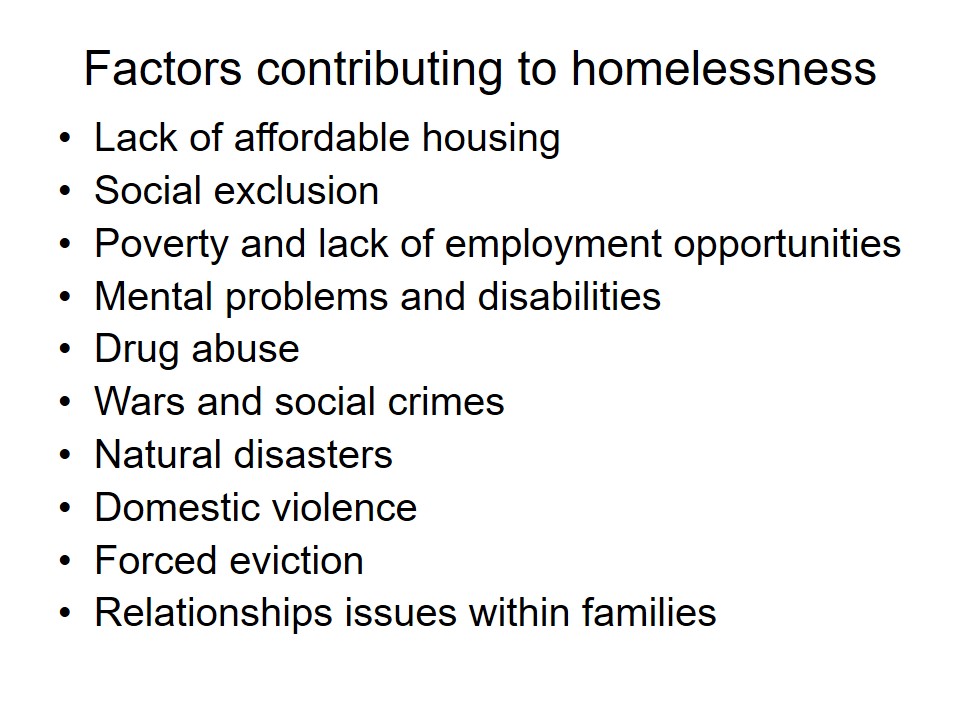
Laws
- Most city laws prohibit or restrict begging, camping, squatting, and or sleeping in a public space (Longstaffe-Gowan, 2012; SNOB(AHA), 2012).
- Cities have engaged in crackdowns on homeless individuals while the police conducts “sweeps” on homeless people.
- Courts have prosecuted homeless person on accounts of breaking city by-laws (Amster, 2008).
- Homeless persons and lawyers have challenged the constitutionality of such laws.
- Homeless persons remain vulnerable to legal challenges and constant prosecution (Wardhaugh, 2000).
- In Hungary, the UN warned that it was a violation of the law that guaranteed legal certainty, right to human dignity and the right to property.
- Such laws led to discriminatory effects on people living in poverty and social exclusion.
- Such laws did not account for the basic rights of homeless people to liberty, privacy, personal security and protection of the family.
- They also ignored international best practices on human rights and violated European democracies.

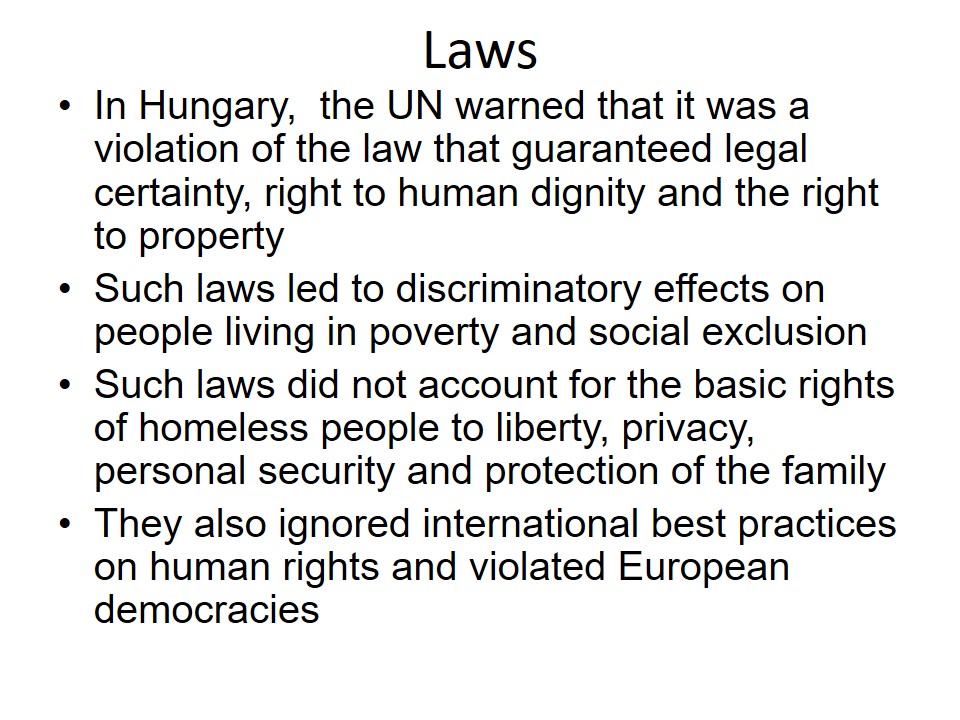
Intolerance of homeless people
- Homeless people face many forms of violence and the rate of such crimes are on the rise.
- Intolerance of homelessness and homeless people by cities, law enforcement agencies, and the public accounts for such violent crimes against homeless people.
- Anti-social behaviour order and prescriptive list of authorised behaviours allow police to harass, threaten or even arrest groups they consider undesirable.
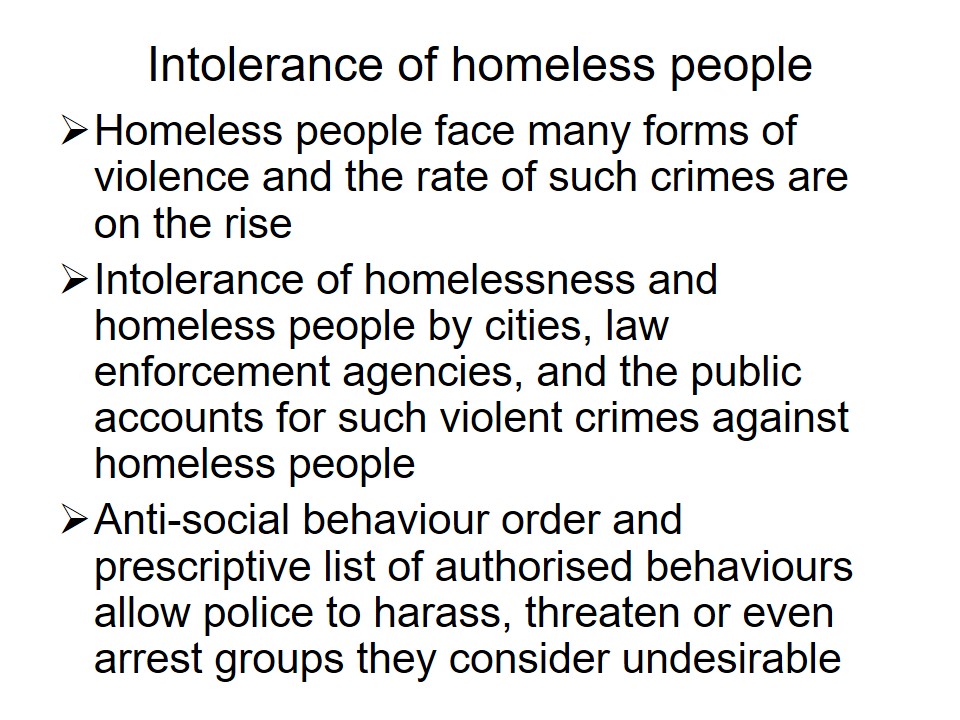
Criminalisation of homelessness
Herbert Breidenbach of International Network of Street Papers (INSP) claims that “criminalising homelessness, especially in public spaces, is futile, anti-democratic, illegal and indicates a self-hatred within society” (Breidenbach, 2012).
Brown (1999) also claims that criminalisation of homelessness is a poor public and misinformed policy (Harding, 1994).
Such critics consider criminalisation of homelessness as a way of removing homeless people out of public sight rather than providing lasting solutions (Cunningham, 1999; Feinberg, 1984).
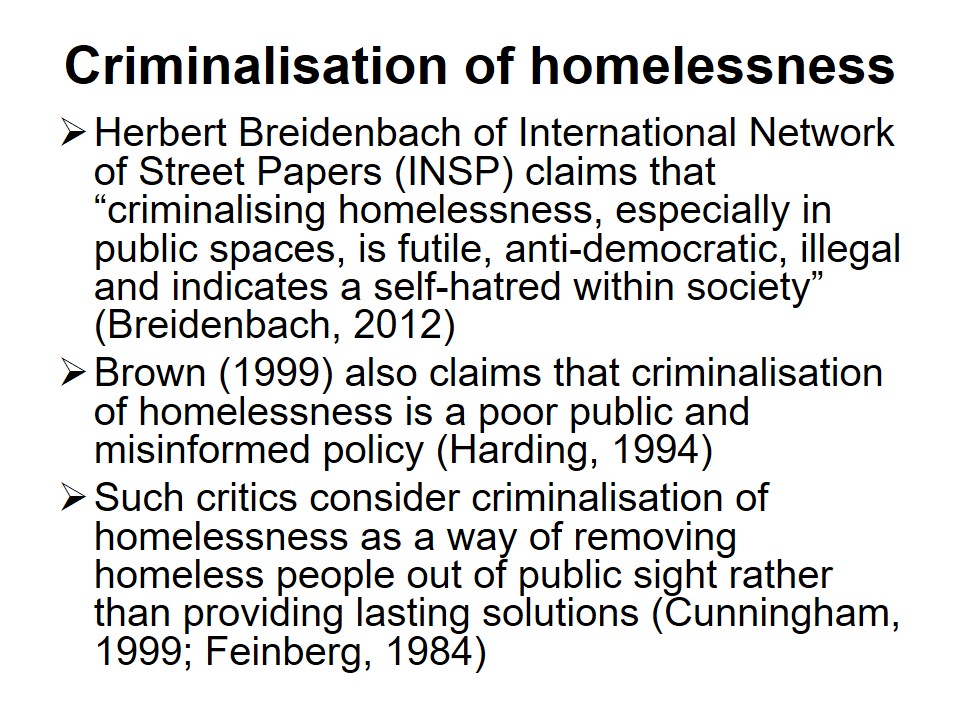
Criminalisation: an ineffective approach
- The approach fails to address the real cause of the problem.
- Homeless people engage in innocent activities.
- Criminalisation of such activities cannot reduce homelessness.
- Homeless people lack alternative places or shelters.
- People who punish poverty (lack of adequate resources and services) are engaging in inhumane and futile activities.
- Criminalisation of homelessness puts extra and unnecessary pressure on law enforcement agencies.
- Criminal justice system cannot address challenges like drug abuse, mental problems and other diseases, which homeless persons experience.
- Instead, health care service providers should handle such issues.
- Police officers lack the required skills for handling health problems of homeless individuals.
- Criminal justice systems do not have proper facilities for handling unique cases of homeless persons.
- Criminalisation does not offer any long-term solutions to homelessness.
- The approach does not address the effective use of public space by everybody (Dennis, 2011).
- It is expensive to keep prisoners than to offer alternative shelters (Brown, 1999).
- The approach is oppressive to marginalised homeless individuals with regard to the use of public space (Garkawe, 2011).
- It goes against the noble idea of co-existence among citizens.

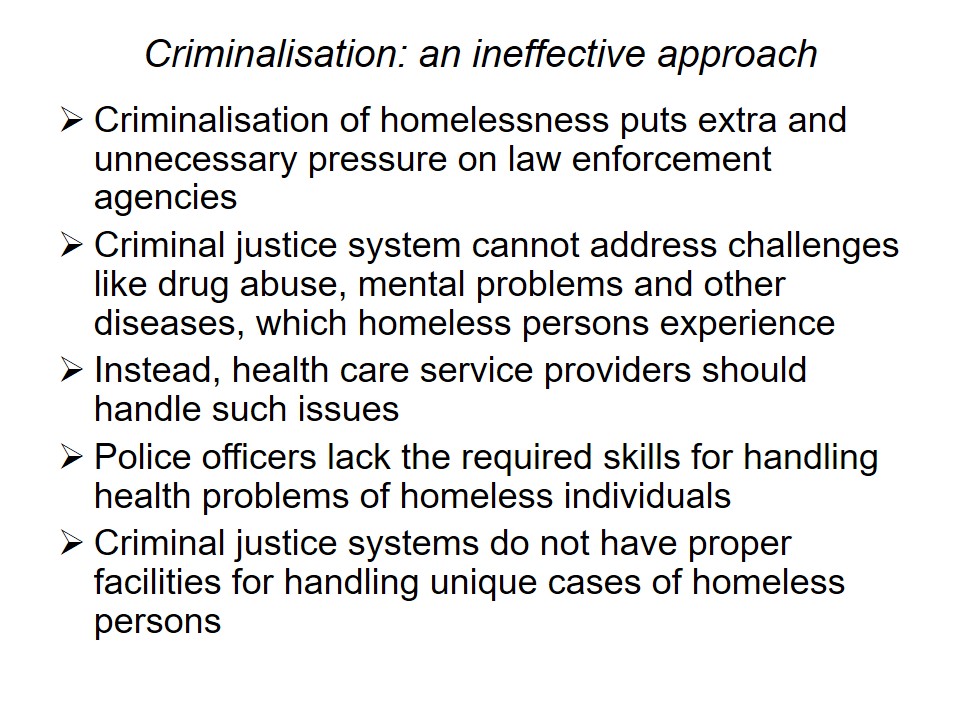
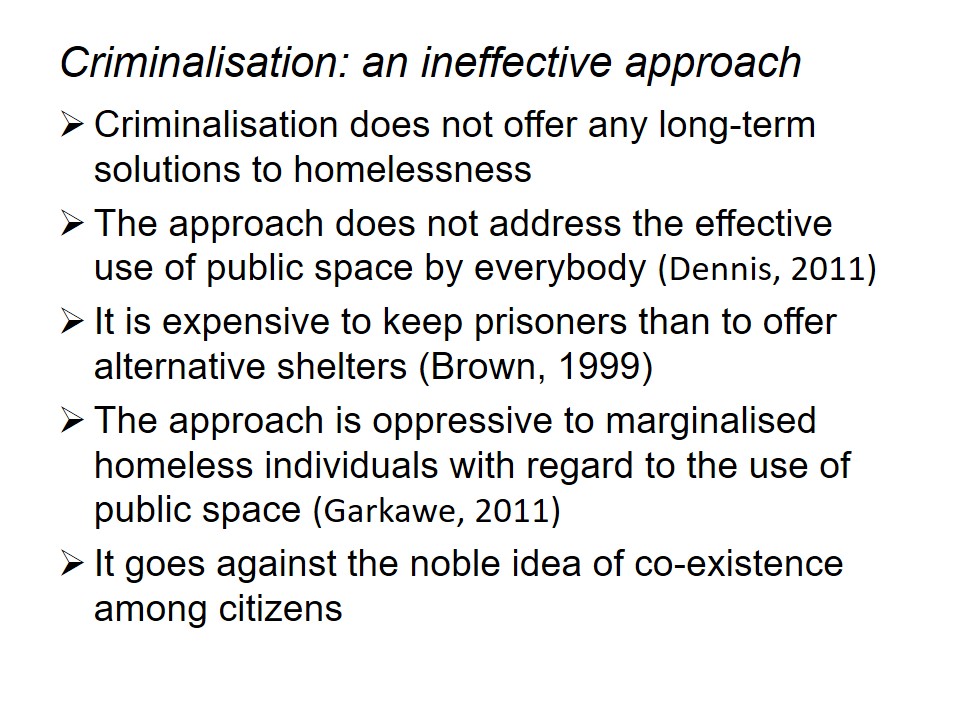
Best approaches to handling homelessness
- Cities should embark on constructive solution to homelessness and the use of public space.
- Courts have ruled that “homelessness is a social issue, which needs to be addressed by the provision of adequate services and not by criminal proceedings” (Sofia Globe, 2012).
- Hungarian government has noted that the country lacks enough shelter for all homeless individuals (this is a similar case across many European cities).
- Reducing homelessness requires constructing many houses.
- Reducing poverty and allowing people to gain access to their social rights.
- The best approaches to solving the problem of homelessness involve collaboration among city officials, police departments, and business communities.
- Homeless individuals and their advocates must also collaborate with others to find solutions.
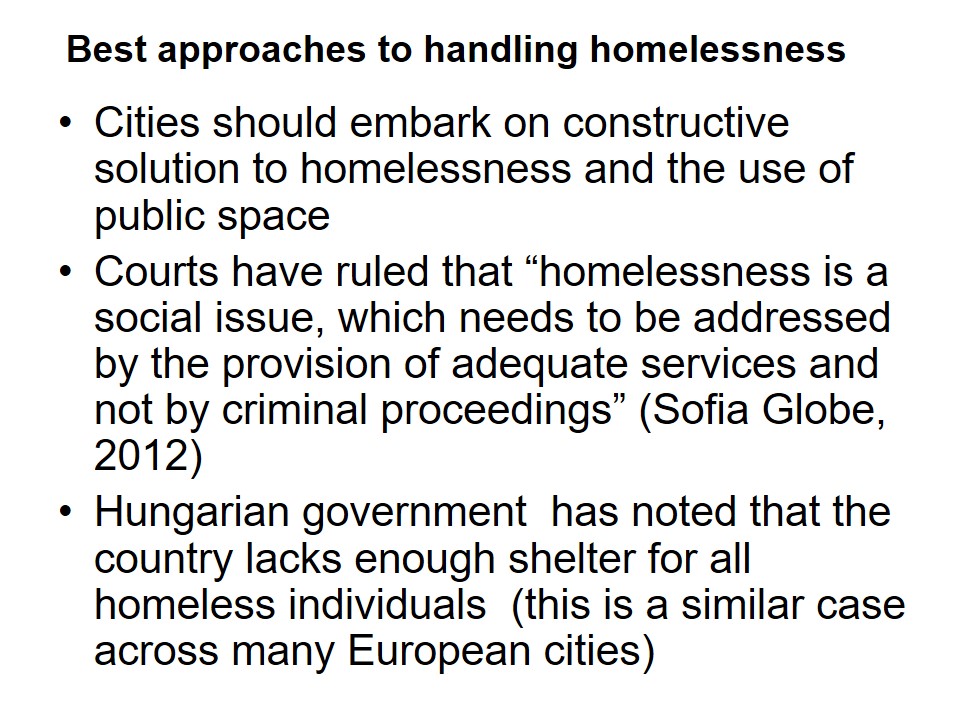
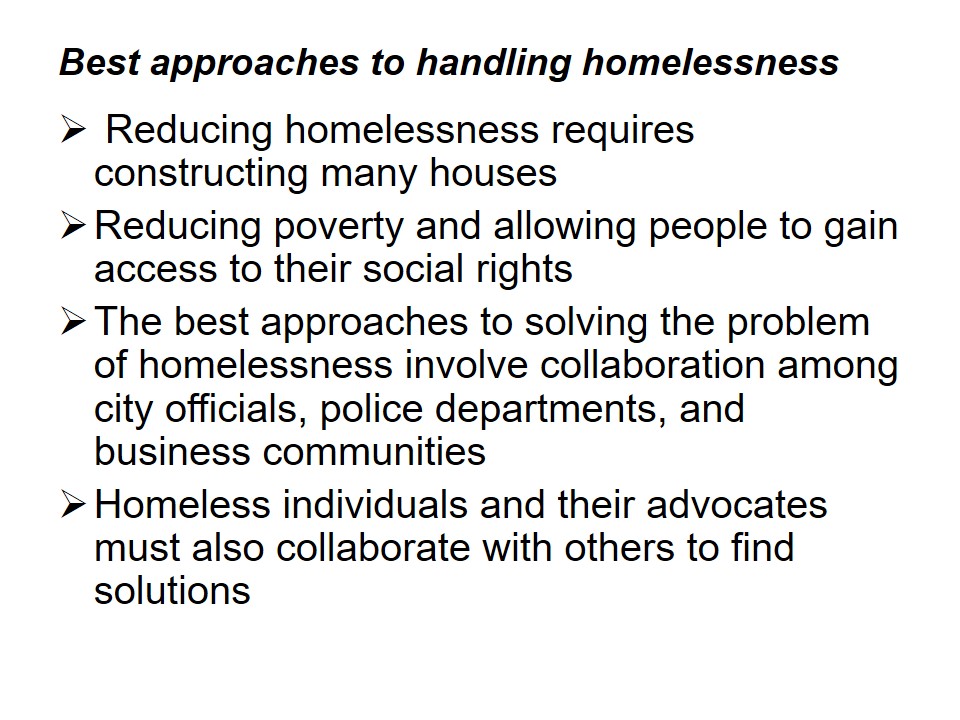
Long-Term Solutions
- The above are some of the ways in which cities can address the problem of homelessness and the use of public space. However, such approaches are not adequate.
- Long-term solutions must address punitive approaches of the criminal justice system.
- The ultimate solution must address the issues of affordable housing and the inadequacy of services, and causes of poverty. These are the underlying causes of homelessness.
- Transitional housing: offers temporary housing for given groups as they plan to get their affordable housing.
- Supportive housing: provides both housing and other social services for the homelessness in order to enhance stability in their lives.
- Pedestrian villages: such places could offer both temporary and permanent homes for the homeless, as well as treatments required.

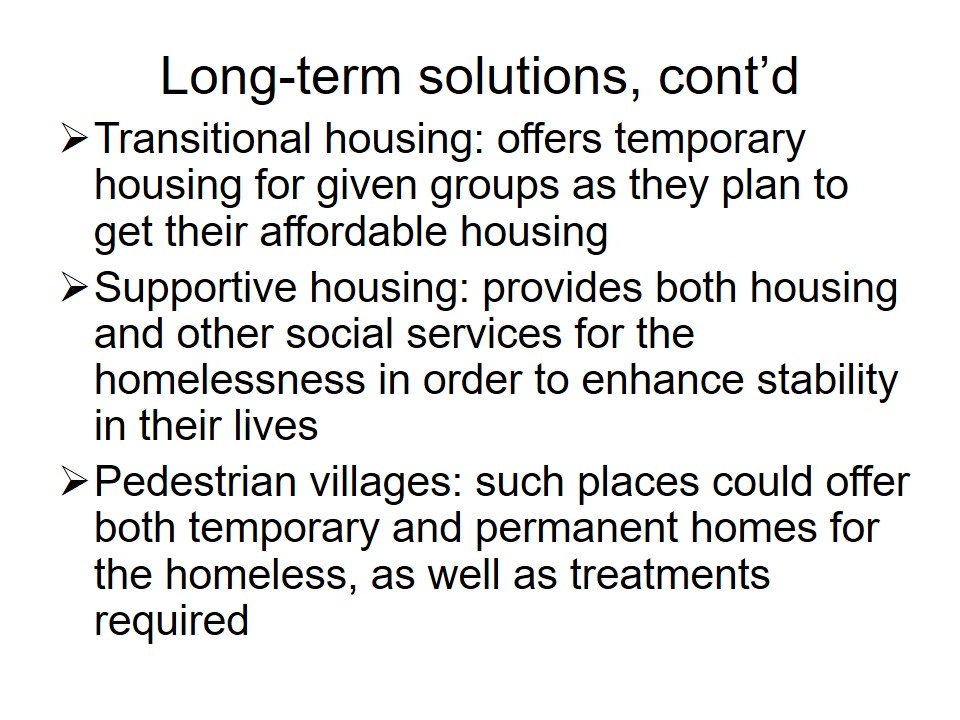
Effective solutions must offer
- Improved access to treatments and services for health problems and drug abuse cases. The police and other law agencies lack such services.
- Improved coordination across different services for the homeless.
- Reduced cases of rising violence against homeless persons.
- Improved studies and evaluations of interventions for future improvement.

Summary and Conclusion
- Poverty is not a crime.
- Homelessness and the use of public space should not force cities to embark on oppression and coercive policies.
- Cities should use the law, resources, and cooperate with other bodies to provide enough housing facilities for the homeless.
- The criminal justice system should not use their time and meagre resources on poor and vulnerable homeless populations.
- Cities, public, and police brutality and intolerance of homelessness and homeless persons do not address causes of homelessness.
- Effective approach to regulating homelessness should involve elimination of homelessness among homeless persons and identifying people who are at the risk of becoming homeless for support.
- Cities need effective policies for problems of homelessness and not punitive laws.
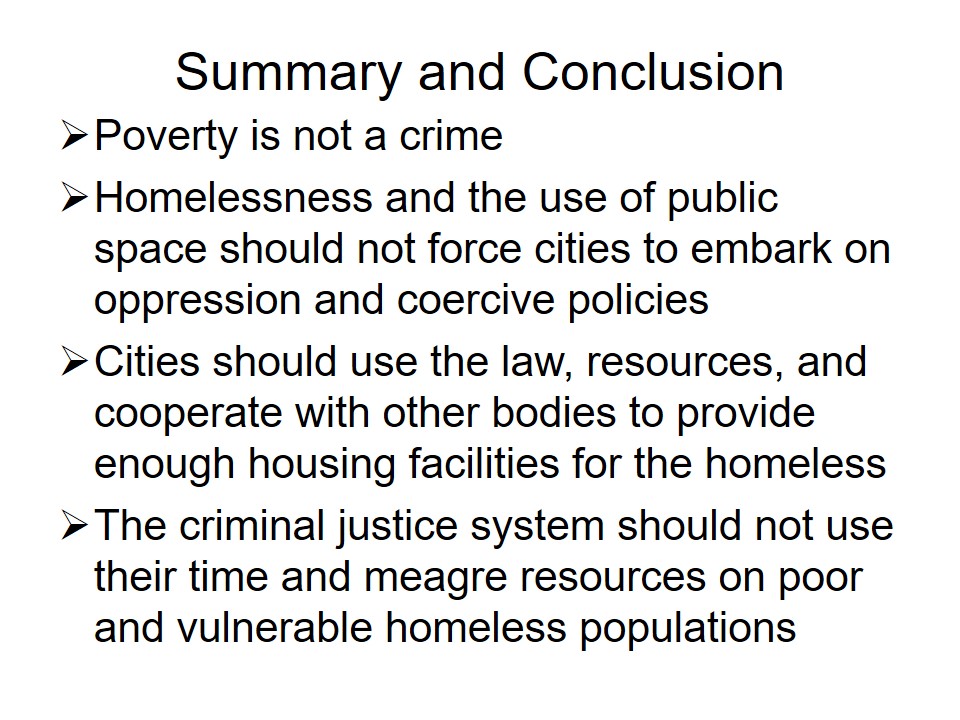
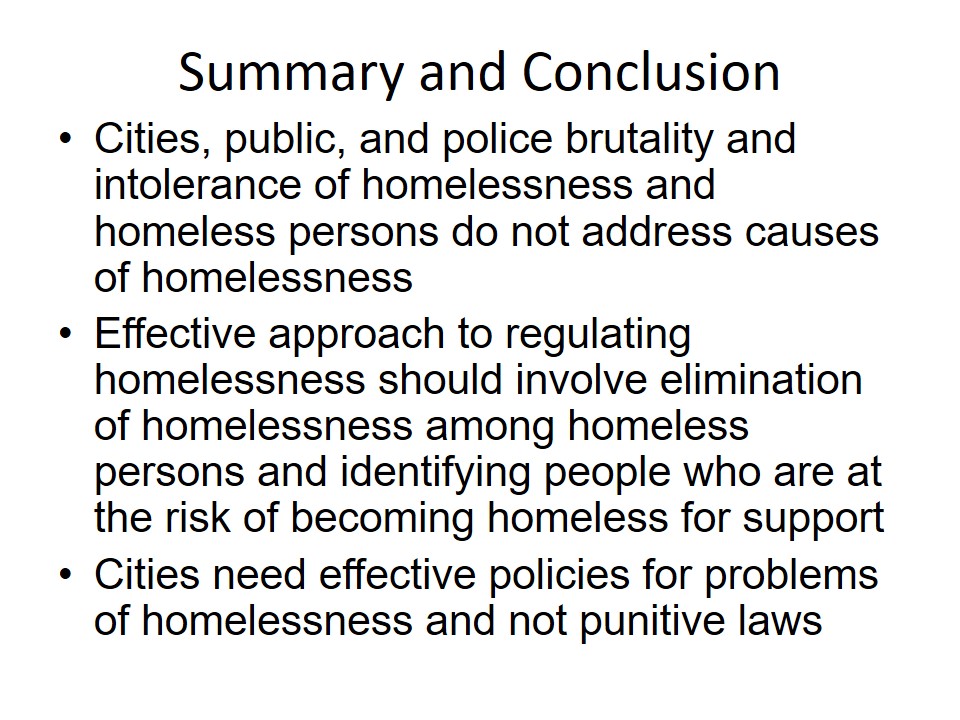
Reference List
- Amster, R 2008, Lost in Space: The Criminalization, Globalization, and Urban Ecology of Homelessness, LFB Scholarly, New York.
- Breidenbach, H 2012, Criminalising homelessness is anti-democratic and instigates hatred. Web.
- Brown, K 1999, ‘Outlawing Homelessness’, National Housing Institute, vol. 106, p. 1.
- Cunningham, K 1999, Out of Sight—Out of Mind, DIANE Publishing, London.
- Dennis, J 2011, The Right Not to be Criminalized: Demarcating Criminal Law’s Authority, Ashgate, London.
- Feinberg, J 1984, Harm to Others: The Moral Limits of the Criminal Law, OUP Publisher, New York.
- Garkawe, S 2011, ‘Modern Victimology: Its Importance, Scope and Relationship with Criminology’, ActaCriminologica, vol. 14, no. 2, pp. 90–99.
- Harding, R 1994, ‘Victimisation, Moral Panics, and the Distortion of Criminal Justice Policy’, Current Issues in Criminal Justice, vol. 6, pp. 27-42.
- Longstaffe-Gowan, T 2012, The London Square: Gardens in the Midst of Town, Yale University Press, New Haven.
- SNOB(AHA) 2012, A Brief and Incomplete History of Squatting in Brighton (and Hove). Web.
- Sofia Globe 2012 UN experts urge Hungary to reverse law criminalising homelessness. Web.
- Wardhaugh, J 2000, Sub city : young people, homelessness and crime, Aldershot, Ashgate.